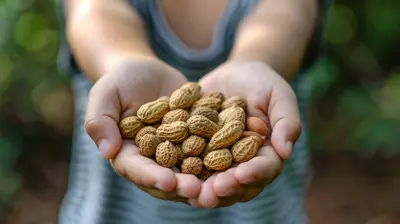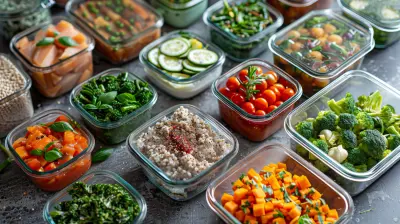How to Manage PMS Symptoms Through Hormonal Balance
3 June 2025
Premenstrual Syndrome (PMS) can feel like an uninvited guest that overstays its welcome every single month. Bloating, mood swings, cramps, fatigue—sound familiar? You're not alone. Around 75% of women experience PMS symptoms at some point in their lives. But what if I told you that balancing your hormones could be the key to managing these monthly struggles?
In this guide, we're diving deep into how you can take control of PMS symptoms by focusing on hormonal equilibrium. Because, let’s face it—life shouldn't be dictated by your cycle.

Understanding PMS and Hormonal Imbalance
First things first, what exactly is PMS? It’s that delightful mix of physical and emotional symptoms that show up in the luteal phase (the 1-2 weeks before your period). But why does it happen?The culprit behind PMS is often hormonal fluctuations, particularly estrogen and progesterone. These hormones play a massive role in mood, energy levels, and overall well-being. When they get out of balance, PMS symptoms can hit you like a ton of bricks.
But here’s the good news: You can regulate your hormones naturally and make that time of the month way more manageable. Let’s talk about how.

Diet: Fuel Your Hormones the Right Way
What you eat has a direct impact on your hormonal health. If your diet consists mainly of processed foods, sugar, and caffeine, your PMS symptoms may be worse than they should be. Here’s how you can adjust your diet to support hormonal balance:1. Increase Magnesium-Rich Foods
Magnesium is known as nature’s chill pill. It helps relax your muscles and reduce stress—two things you desperately need when PMS kicks in. Foods high in magnesium include:- Dark leafy greens (spinach, kale)
- Nuts and seeds (almonds, pumpkin seeds)
- Dark chocolate (yes, really!)
- Avocados
2. Prioritize Healthy Fats
Hormones are made from fats, so if you’re depriving your body of good fats, you're likely worsening the imbalance. Focus on:- Avocados
- Olive oil
- Nuts and seeds
- Fatty fish like salmon
3. Cut Back on Sugar and Refined Carbs
Sugar spikes insulin levels, which can throw your hormones into chaos. Swap processed sweets for natural sugars like fruit, and trade white bread for whole grains.4. Stay Hydrated
Dehydration can make bloating and fatigue worse. Aim for at least 8 glasses of water a day, and if you need more flavor, add lemon or cucumber slices.
Supplements to Support Hormonal Balance
While food should be your primary source of nutrients, sometimes our bodies need an extra boost. Here are some effective supplements for managing PMS:1. Vitex (Chasteberry)
This herb has been used for centuries to help regulate the menstrual cycle and reduce PMS symptoms. It works by supporting progesterone production, which often drops too low during PMS.2. Vitamin B6
B6 is a game-changer for mood swings and irritability. It supports neurotransmitters like serotonin, which help keep you feeling emotionally stable.3. Omega-3 Fatty Acids
These anti-inflammatory powerhouses can help reduce cramps and mood swings. You can get them from fish oil supplements or plant-based sources like flaxseeds and chia seeds.4. Calcium & Vitamin D
Studies show that women with low calcium levels tend to experience worse PMS symptoms. Pairing calcium with vitamin D improves absorption and overall bone health.
Lifestyle Changes That Make a Difference
Small daily habits can significantly improve hormonal balance and reduce PMS symptoms. Let’s take a look at some effective lifestyle tweaks:1. Move Your Body (But Listen to It)
Exercise helps regulate hormones and boost endorphins (your body's natural mood lifters). However, during PMS, you might not feel like running a marathon—and that’s okay. Try:- Yoga for relaxation
- Walking to reduce bloating
- Light strength training for energy boosts
2. Get Enough Sleep
Ever notice how PMS symptoms feel 10 times worse when you’re sleep-deprived? Poor sleep affects cortisol (the stress hormone), which can disrupt your entire endocrine system. Aim for 7-9 hours of quality sleep.3. Manage Stress Levels
Stress is one of the biggest hormone disruptors. When cortisol is high, estrogen and progesterone can get out of sync, making PMS symptoms worse. Try:- Meditation or deep breathing
- Spending time in nature
- Journaling your thoughts and emotions
4. Reduce Caffeine & Alcohol
Yes, I know—coffee and wine are lifesavers. But too much caffeine can spike cortisol, and alcohol can mess with estrogen levels. If you rely on coffee, try switching to matcha or herbal teas before your period.Tracking Your Symptoms
One of the most powerful things you can do is track your cycle and PMS symptoms. Apps like Clue, Flo, or even a simple journal can help you spot patterns and adjust your lifestyle accordingly.By understanding when symptoms hit hardest, you can plan ahead—whether that means stocking up on magnesium-rich snacks, scheduling a yoga class, or simply giving yourself grace to rest.
When to Seek Professional Help
If your PMS symptoms feel debilitating or interfere with daily life, it’s worth speaking with a healthcare provider. Conditions like PMDD (Premenstrual Dysphoric Disorder) or hormone imbalances like PCOS could be at play, and treatment options may be necessary.Final Thoughts
Managing PMS through hormonal balance is absolutely possible—you just need the right tools. By tweaking your diet, incorporating helpful supplements, adopting better lifestyle habits, and tracking your symptoms, you can significantly reduce discomfort and take back control of your cycle.Remember, your hormones shouldn’t hold you hostage every month. Small, consistent changes can make a world of difference. So why not start today?
all images in this post were generated using AI tools
Category:
Healthy HormonesAuthor:

Madeline Howard
Discussion
rate this article
3 comments
Kismet McVey
Great tips! Balancing hormones can truly transform the PMS experience. Here’s to feeling joyful and vibrant every month!
June 13, 2025 at 2:53 PM

Madeline Howard
Thank you! I'm glad you found the tips helpful. Celebrating vibrant health every month is the goal!
Shiloh Rios
This article offers practical tips for managing PMS symptoms through hormonal balance. It's refreshing to see straightforward advice on diet and lifestyle changes that can make a real difference. Worth a read!
June 8, 2025 at 3:35 PM

Madeline Howard
Thank you for your feedback! I'm glad you found the tips helpful and practical. Your health journey is important!
Colin McKenzie
Finding hormonal balance is key to easing PMS symptoms; small lifestyle changes can lead to significant improvements in well-being.
June 8, 2025 at 3:37 AM

Madeline Howard
Absolutely! Hormonal balance is essential for managing PMS, and even minor lifestyle adjustments can make a big difference in alleviating symptoms.



